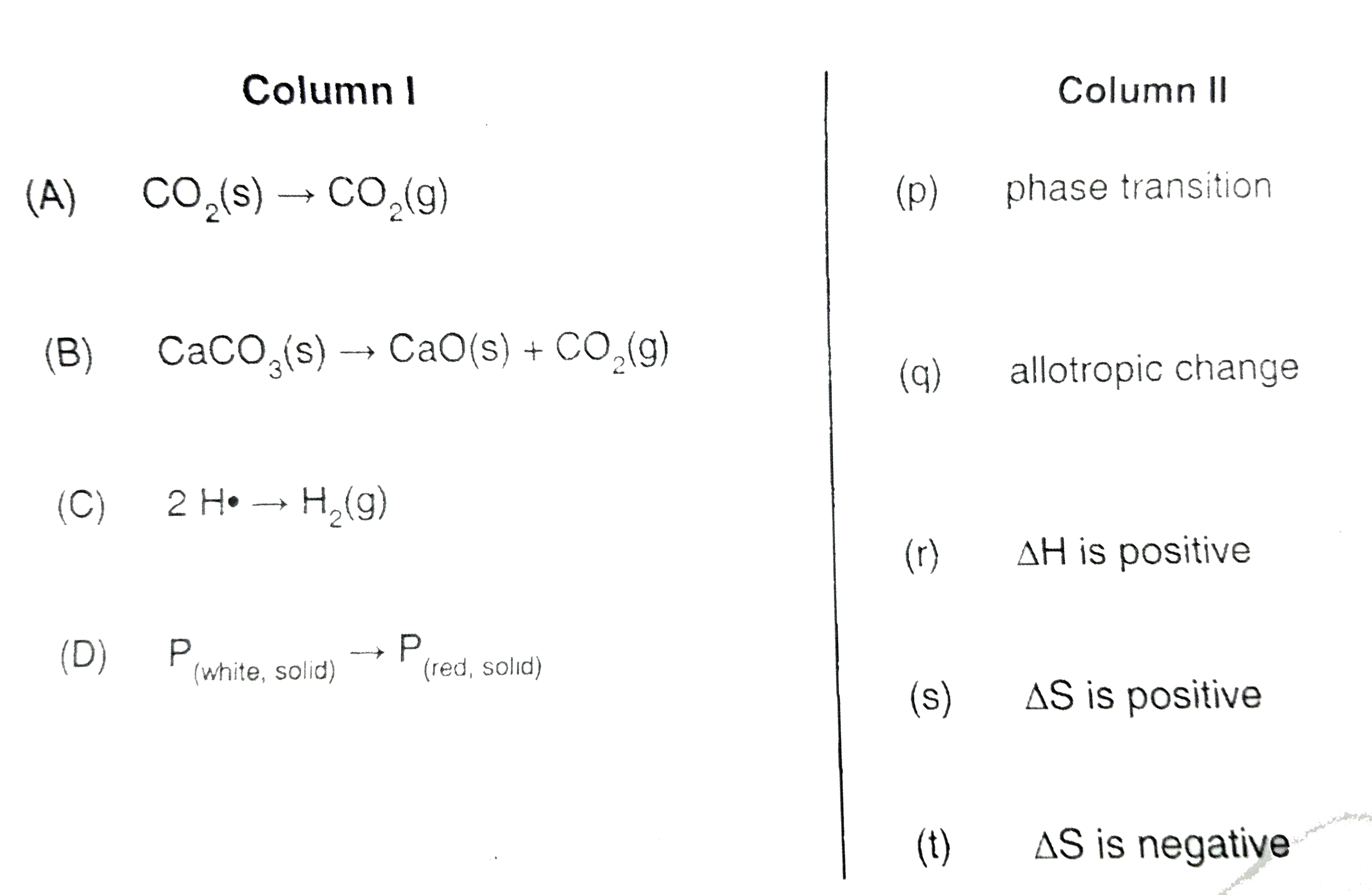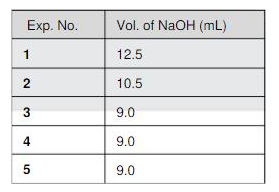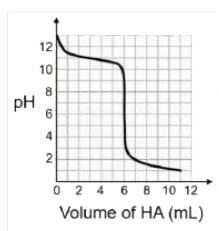Properties such as boiling point, freezing point and vapour pressure of a pure solvent change when solute molecules are added to get homogeneous solution. These are called colligative properties. Applications of colligative properties are very useful in day-to-day life. One of its examples is the use of ethylene glycol and water mixture as anti-freezing liquid in the radiator of automobiles.
A solution M is prepared by mixing ethanol and water. Thus moel fraction of ethanol in the mixture is 0.9.
Given: Freezing point depression constant of water
(Kwaterf)=1.86Kkgmol−1
Freezing point depression constant of ethanol
(Kethanolf)=2.0Kkgmol−1
Boiling point elevation constant of water
(Kwaterb)=0.52Kkgmol−1
Boiling point elevation constant of ethanol
(Kethanolb)=1.2Kkgmol−1
Standard freezing point of water =273K
Standard freezing point of ethanol =155.7K
Standard boiling point of water =373K
Standard boiling point of ethanol =351.5K
vapour pressure of pure water =32.8mmHg
Vapour pressure of pure ethanol =40mmHg
Molecualr weight of water =18gmol−1
Molecular weight of ethanol =46gmol−1
In asweering the following questions, consider the solutions to be ideal dilute solutions and solutes to be non-volatile and non-dissociative.
The vapour pressure of the solution M is:
39.3 mm Hg
36.0 mm Hg
29.5 mm Hg
28.8 mm Hg
The correct Answer is:B
Step by step video, text & image solution for Properties such as boiling point, freezing point and vapour pressure of a pure solvent change when solute molecules are added to get homogeneous solution. These are called colligative properties. Applications of colligative properties are very useful in day-to-day life. One of its examples is the use of ethylene glycol and water mixture as anti-freezing liquid in the radiator of automobiles. A solution M is prepared by mixing ethanol and water. Thus moel fraction of ethanol in the mixture is 0.9. Given: Freezing point depression constant of water (K_(f)^("water")) = 1.86 K kg mol^(-1) Freezing point depression constant of ethanol (K_(f)^("ethanol")) = 2.0 K kg mol^(-1) Boiling point elevation constant of water (K_(b)^("water")) = 0.52 K kg mol^(-1) Boiling point elevation constant of ethanol (K_(b)^("ethanol")) = 1.2 K kg mol^(-1) Standard freezing point of water = 273 K Standard freezing point of ethanol = 155.7K Standard boiling point of water = 373 K Standard boiling point of ethanol = 351.5 K vapour pressure of pure water = 32.8 mm Hg Vapour pressure of pure ethanol = 40 mm Hg Molecualr weight of water = 18 g mol^(-1) Molecular weight of ethanol = 46 g mol^(-1) In asweering the following questions, consider the solutions to be ideal dilute solutions and solutes to be non-volatile and non-dissociative. The vapour pressure of the solution M is: by Chemistry experts to help you in doubts & scoring excellent marks in Class 12 exams.
Updated on:21/07/2023Topper's Solved these Questions
- JEE ADVANCEDBook:JEE ADVANCED PREVIOUS YEARChapter:JEE ADVANCEDExercise:SECTION-I (Single Correct Choice Type )
Explore 12 Videos
- JEE ADVANCEDBook:JEE ADVANCED PREVIOUS YEARChapter:JEE ADVANCEDExercise:SECTION-II(Multiple Correct Choice Type )
Explore 4 Videos
- JEE ADVANCEDBook:JEE ADVANCED PREVIOUS YEARChapter:JEE ADVANCEDExercise:CHEMISTRY SECTION - IV : Matric Match Type
Explore 2 Videos
- JEE (ADVANCED ) 2020Book:JEE ADVANCED PREVIOUS YEARChapter:JEE (ADVANCED ) 2020Exercise:SECTION -III
Explore 6 Videos
- JEE ADVANCED 2020Book:JEE ADVANCED PREVIOUS YEARChapter:JEE ADVANCED 2020Exercise:SECTION-3
Explore 6 Videos
Similar Questions
Given that the abundacne of isotopes .54Fe, .56Fe, and .57Fe is 5%, 90% and 5% respectively. The atomic mass of Fe is
View SolutionThe correct statement regarding defects in crystalling solids.
View SolutionMatch the transformation in column I with appropriate options in column II

View Solution5.00 mL of 0.10 M oxalic acid solution taken in a conical flask is titrated against NaOH from a burette using phenolphthalein indicator. The volume of NaOH required for the appearance of permanent faint pink color is tabulated below for five experiments. What is the concentration, in molarity, of the NaOH solution?

View SolutionA solution of 0 .1 weak base (B )is titrated with 0.1 M of a strong acid ( HA) . The variation of pH of the solution will be the volume of HA added is shown in the figure below. What is the pKb of the base ? The neutralization reaction is given by B+HA→HA→BH++A−

View SolutionProperties such as boiling point, freezing point, and vapour pressure of a pure solvent change when solute molecules are added to get homogenous solution. These are called colligative properties.
Anwer the following questions:
i.0.1 M ethanol
ii.0.1mBa3(PO4)3
iii.0.1mNa2SO4
Increasing order of freezing points
View SolutionProperties such as boiling point, freezing point, and vapour pressure of a pure solvent change when solute molecules are added to get homogenous solution. These are called colligative properties.
Anwer the following questions:
i.0.1 M glucose
ii.1% urea solution
iii.0.1 M common salt
Increasing order of osmotic pressure
View SolutionProperties such as boiling point, freezing point and vapour pressure of a pure solvent change when solute molecules are added to homegenous solution. These are called colligative properties. Applications of colligative properties are very useful in day to day life. One of its exaples is the use of ethylene glycol and water mixtue as anti-freezing liquid in the radiators of automobiles. A solution M is prepared by mixing ehanol and water. The mole fraction of ethanol in the mixture is 0.9 Given.
Kfof water=1.86K kg mol−1
Kfof ethanol=2.0K kg mol−1
Kbfor water =0.52K kg mol−1
Kb of ethanol=1.2K kg mol−1
Tf(water)=273K
Tf(ethanol)=155.7K
T∘b(water)=373K
T∘b(ethanol)=351.5K
P∘(water)32.8mmHg.
P∘(ethanol)=40mmHg
M(ethanol)==46g mol−1
M(water)=18g mol−1
In answering the following quesion, consider the solutions to be ideal dilute solutions ans solute to be non-voltile and non-dissoviative.
(5) The freezing point of solution M is:
View SolutionProperties such as boiling point, freezing point and vapour pressure of a pure solvent change when solute molecules are added to homegenous solution. These are called colligative properties. Applications of colligative properties are very useful in day to day life. One of its exaples is the use of ethylene glycol and water mixtue as anti-freezing liquid in the radiators of automobiles. A solution M is prepared by mixing ehanol and water. The mole fraction of ethanol in the mixture is 0.9 Given. K_(f)"of water"=1.86 "K kg mol"^(-1) K_(f)"of ethanol" = 2.0 "K kg mol"^(-1) K_(b)"for water "=0.52 "K kg mol"^(-1) K_(b)" of ethanol"=1.2 "K kg mol"^(-1) T_(f)("water")=273 K T_(f)("ethanol")=155.7 K T_(b)^(@) ("water")=373 K T_(b)^(@)("ethanol")=351.5 K P^(@)("water")32.8 mm Hg. P^(@)("ethanol")=40 mmHg M("ethanol")==46 "g mol"^(-1) M("water")=18"g mol"^(-1) In answering the following quesion, consider the solutions to be ideal dilute solutions ans solute to be non-voltile and non-dissoviative. (6) The vapour pressure of solution M is :
View SolutionProperties such as boiling point, freezing point and vapour pressure of a pure solvent change when solute molecules are added to homegenous solution. These are called colligative properties. Applications of colligative properties are very useful in day to day life. One of its exaples is the use of ethylene glycol and water mixtue as anti-freezing liquid in the radiators of automobiles. A solution M is prepared by mixing ehanol and water. The mole fraction of ethanol in the mixture is 0.9 Given. K_(f)"of water"=1.86 "K kg mol"^(-1) K_(f)"of ethanol" = 2.0 "K kg mol"^(-1) K_(b)"for water "=0.52 "K kg mol"^(-1) K_(b)" of ethanol"=1.2 "K kg mol"^(-1) T_(f)("water")=273 K T_(f)("ethanol")=155.7 K T_(b)^(@) ("water")=373 K T_(b)^(@)("ethanol")=351.5 K P^(@)("water")32.8 mm Hg. P^(@)("ethanol")=40 mmHg M("ethanol")==46 "g mol"^(-1) M("water")=18"g mol"^(-1) In answering the following quesion, consider the solutions to be ideal dilute solutions ans solute to be non-voltile and non-dissoviative. (7) water is added to the solution M such that the mole fraction so wter in solution becomes 0.9. The boiling point of solution is :
View SolutionProperties such as boiling point, freezing point and vapour, pressure of a pure solvent change Propeties such as boiling point, freezing point and vapour, pressure of a pure solvent change when solute molecules are added to get homogeneous solution. These are called colligative properties. Applications of colligative properties are very useful in day-to-day life. One of its examples is the use of ethylene glycol and water mixture as anti-freezing liquid in the radiator of automobiles.
A solution M is prepared by mixing athanol and water. The mole fraction of ethanol in the mixture is 0.9
Given Freezing point depression constant of water (Kwaterf)=1.86Kkgmol−1
Freezing point depression constant of ethanol (Kethanolf)=2.0Kkgmol−1
Boiling point elevation constant of water (Kwaterb)=0.52kgmol−1
Boiling point elevation constant of ethanol (Kethanolb)=1.2kgmol−1
Standard freezing point of water =273 K
Standard freezing point of ethanol = 155.7 K
Standard boiling point of water =373 K
tandard boiling point of ethanol =351.5 K
Vapour pressure of pure water =32.8 mmHg
Vapour presure of pure ethanol =40g Hg
Molecular weight of water =18gmol−1
Molecules weight of ethanol =46gmol−1
In answering the following questions, consider the solutions to be ideal dilute solutions and solutes to be non-volatile and non-dissociative.
when solute molecules are added to get homogeneous solution. These are called colligative properties. Applications of colligative properties are very useful in day-to-day life. One of its examples is the use of ethylene glycol and water mixture as anti-freezing liquid in the radiator of automobiles.
A solution M is prepared by mixing athanol and water. The mole fraction of ethanol in the mixture is 0.9
Given Freezing point depression constant of water (Kwaterf)=1.86Kkgmol−1
Freezing point depression constant of ethanol (Kethanolf)=2.0Kkgmol−1
Boiling point elevation constant of water (Kwaterb)=0.52kgmol−1
Boiling point elevation constant of ethanol (Kethanolb)=1.2kgmol−1
Standard freezing point of water =273 K
Standard freezing point of ethanol = 155.7 K
Standard boiling point of water =373 K
tandard boiling point of ethanol =351.5 K
Vapour pressure of pure water =32.8 mmHg
Vapour presure of pure ethanol =40g Hg
Molecular weight of water =18gmol−1
Molecules weight of ethanol =46gmol−1
In answering the following questions, consider the solutions to be ideal dilute solutions and solutes to be non-volatile and non-dissociative.
The freezing point of the solution M is
View SolutionProperties such as boiling point, freezing point and vapour, pressure of a pure solvent change Propeties such as boiling point, freezing point and vapour, pressure of a pure solvent change when solute molecules are added to get homogeneous solution. These are called colligative properties. Applications of colligative properties are very useful in day-to-day life. One of its examples is the use of ethylene glycol and water mixture as anti-freezing liquid in the radiator of automobiles.
A solution M is prepared by mixing athanol and water. The mole fraction of ethanol in the mixture is 0.9
Given Freezing point depression constant of water (Kwaterf)=1.86Kkgmol−1
Freezing point depression constant of ethanol (Kethanolf)=2.0Kkgmol−1
Boiling point elevation constant of water (Kwaterb)=0.52kgmol−1
Boiling point elevation constant of ethanol (Kethanolb)=1.2kgmol−1
Standard freezing point of water =273 K
Standard freezing point of ethanol = 155.7 K
Standard boiling point of water =373 K
tandard boiling point of ethanol =351.5 K
Vapour pressure of pure water =32.8 mmHg
Vapour presure of pure ethanol =40g Hg
Molecular weight of water =18gmol−1
Molecules weight of ethanol =46gmol−1
In answering the following questions, consider the solutions to be ideal dilute solutions and solutes to be non-volatile and non-dissociative.
when solute molecules are added to get homogeneous solution. These are called colligative properties. Applications of colligative properties are very useful in day-to-day life. One of its examples is the use of ethylene glycol and water mixture as anti-freezing liquid in the radiator of automobiles.
A solution M is prepared by mixing athanol and water. The mole fraction of ethanol in the mixture is 0.9
Given Freezing point depression constant of water (Kwaterf)=1.86Kkgmol−1
Freezing point depression constant of ethanol (Kethanolf)=2.0Kkgmol−1
Boiling point elevation constant of water (Kwaterb)=0.52kgmol−1
Boiling point elevation constant of ethanol (Kethanolb)=1.2kgmol−1
Standard freezing point of water =273 K
Standard freezing point of ethanol = 155.7 K
Standard boiling point of water =373 K
tandard boiling point of ethanol =351.5 K
Vapour pressure of pure water =32.8 mmHg
Vapour presure of pure ethanol =40g Hg
Molecular weight of water =18gmol−1
Molecules weight of ethanol =46gmol−1
In answering the following questions, consider the solutions to be ideal dilute solutions and solutes to be non-volatile and non-dissociative.
The vapour pressure of the solution M is
View SolutionProperties such as boiling point, freezing point and vapour, pressure of a pure solvent change Propeties such as boiling point, freezing point and vapour, pressure of a pure solvent change when solute molecules are added to get homogeneous solution. These are called colligative properties. Applications of colligative properties are very useful in day-to-day life. One of its examples is the use of ethylene glycol and water mixture as anti-freezing liquid in the radiator of automobiles.
A solution M is prepared by mixing athanol and water. The mole fraction of ethanol in the mixture is 0.9
Given Freezing point depression constant of water (Kwaterf)=1.86Kkgmol−1
Freezing point depression constant of ethanol (Kethanolf)=2.0Kkgmol−1
Boiling point elevation constant of water (Kwaterb)=0.52kgmol−1
Boiling point elevation constant of ethanol (Kethanolb)=1.2kgmol−1
Standard freezing point of water =273 K
Standard freezing point of ethanol = 155.7 K
Standard boiling point of water =373 K
tandard boiling point of ethanol =351.5 K
Vapour pressure of pure water =32.8 mmHg
Vapour presure of pure ethanol =40g Hg
Molecular weight of water =18gmol−1
Molecules weight of ethanol =46gmol−1
In answering the following questions, consider the solutions to be ideal dilute solutions and solutes to be non-volatile and non-dissociative.
when solute molecules are added to get homogeneous solution. These are called colligative properties. Applications of colligative properties are very useful in day-to-day life. One of its examples is the use of ethylene glycol and water mixture as anti-freezing liquid in the radiator of automobiles.
A solution M is prepared by mixing athanol and water. The mole fraction of ethanol in the mixture is 0.9
Given Freezing point depression constant of water (Kwaterf)=1.86Kkgmol−1
Freezing point depression constant of ethanol (Kethanolf)=2.0Kkgmol−1
Boiling point elevation constant of water (Kwaterb)=0.52kgmol−1
Boiling point elevation constant of ethanol (Kethanolb)=1.2kgmol−1
Standard freezing point of water =273 K
Standard freezing point of ethanol = 155.7 K
Standard boiling point of water =373 K
tandard boiling point of ethanol =351.5 K
Vapour pressure of pure water =32.8 mmHg
Vapour presure of pure ethanol =40g Hg
Molecular weight of water =18gmol−1
Molecules weight of ethanol =46gmol−1
In answering the following questions, consider the solutions to be ideal dilute solutions and solutes to be non-volatile and non-dissociative.
Water is added to the solution M such that the fraction of water in the solution becomes 0.9. The boiling point of this solutions is
View SolutionLiquid Solutions | Third Colligative Property: Depression In Freezing Point
View Solutionसमांगी विलयन में विलेय के अणु मिलाने पर शुद्ध विलायक के गुण जैसे क्वथनांक, हिमांक तथा वाष्पदाब परिवर्तित हो जाते हैं। इन गुणों को अणु संख्यक गुण धर्म कहते हैं। अणु संख्यक गुणधर्म हमारे दैनिक जीवन में बहुत उपयोगी होते हैं। ऑटोमोबाईल के रेडियेटर में एथिलीन ग्लायकॉल तथा जल के मिश्रण का एन्टी-हिमीभूत द्रव के रूप में उपयोग इसका एक उदाहरण है।
एथेनॉल तथा जल के मिश्रण से एक विलयन M निर्मित होता है। मिश्रण में एथेनॉल का मोल प्रभाज 0.9 है।
दिया गया है : जल का हिमांक अवनमन स्थिरांक (Kजलf)=1.86Kkg mol−1
एथेनॉल का हिमांक अवनमन स्थिरांक (Kethanolf)=2.0K kg mol−1
जल का क्वथनांक उन्नयन स्थिरांक (Kजल)=0.52Kkgmol−1
एथेनॉल का क्वथनांक उन्नयन स्थिरांक (Kethanolb)=1.2Kkgmol−1
जल का मानक हिमांक = 273K
एथेनॉल का मानक हिमांक = 155.7K
जल का मानक क्वथनांक = 373K
एथेनॉल का मानक क्वथनांक = 351.5K
शुद्ध जल का वाष्पदाब = 32.8mmHg
शुद्ध एथेनॉल का वाष्पदाब = 40mmHg
जल का आण्विक भार = 18gmol−1
एथेनॉल का आण्विक भार =46gmol−1
इन प्रश्न का उत्तर देते समय, यह मान लीजिये कि विलयन आदर्श तनु विलयन है तथा विलेय अवाष्पशील तथा अविभाजित है।
विलयन M का हिमांक है
View Solutionसमांगी विलयन में विलेय के अणु मिलाने पर शुद्ध विलायक के गुण जैसे क्वथनांक, हिमांक तथा वाष्पदाब परिवर्तित हो जाते हैं। इन गुणों को अणु संख्यक गुण धर्म कहते हैं। अणु संख्यक गुणधर्म हमारे दैनिक जीवन में बहुत उपयोगी होते हैं। ऑटोमोबाईल के रेडियेटर में एथिलीन ग्लायकॉल तथा जल के मिश्रण का एन्टी-हिमीभूत द्रव के रूप में उपयोग इसका एक उदाहरण है।
एथेनॉल तथा जल के मिश्रण से एक विलयन M निर्मित होता है। मिश्रण में एथेनॉल का मोल प्रभाज 0.9 है।
दिया गया है : जल का हिमांक अवनमन स्थिरांक (Kजलf)=1.86Kkg mol−1
एथेनॉल का हिमांक अवनमन स्थिरांक (Kethanolf)=2.0K kg mol−1
जल का क्वथनांक उन्नयन स्थिरांक (Kजल)=0.52Kkgmol−1
एथेनॉल का क्वथनांक उन्नयन स्थिरांक (Kethanolb)=1.2Kkgmol−1
जल का मानक हिमांक = 273K
एथेनॉल का मानक हिमांक = 155.7K
जल का मानक क्वथनांक = 373K
एथेनॉल का मानक क्वथनांक = 351.5K
शुद्ध जल का वाष्पदाब = 32.8mmHg
शुद्ध एथेनॉल का वाष्पदाब = 40mmHg
जल का आण्विक भार = 18gmol−1
एथेनॉल का आण्विक भार =46gmol−1
इन प्रश्न का उत्तर देते समय, यह मान लीजिये कि विलयन आदर्श तनु विलयन है तथा विलेय अवाष्पशील तथा अविभाजित है।
विलयन M का वाष्पदाब है।
View Solution